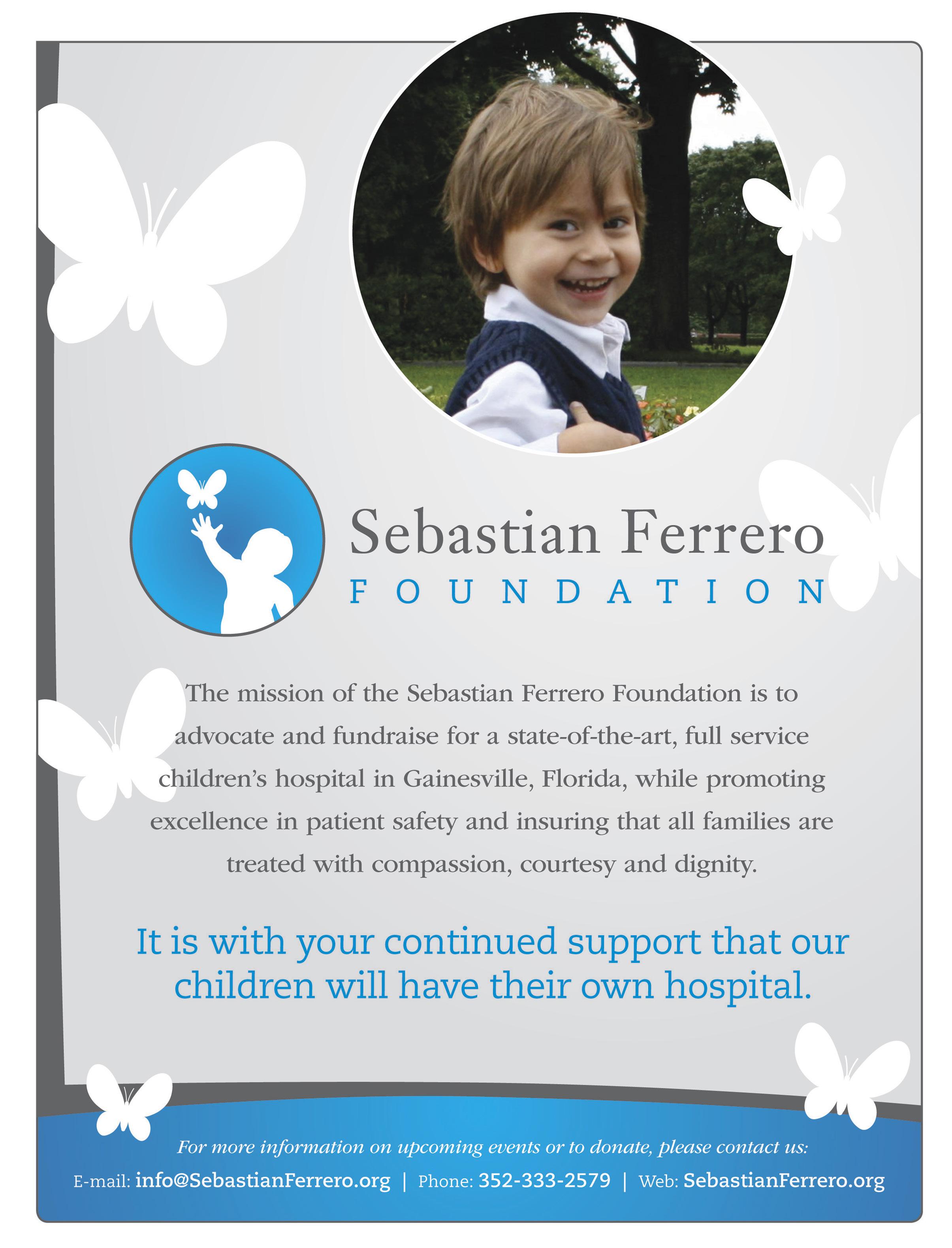

Stronger,
healthier babies.
Every day, we do all we can to make sure every baby is born healthy. Find out how we’re helping a baby you love at marchofdimes.com.




healthier babies.
Every day, we do all we can to make sure every baby is born healthy. Find out how we’re helping a baby you love at marchofdimes.com.

Nicole Irving President
Shane Irving Vice President
Managing Editor Chris Wilson Art Director Leslie Vega
Contributing Writers
Wendy Joysen, Alison Walker, Mary Reichardt, Sara Powell, Jillian Rogers, Michelle Ashworth, Rachael Pino, Tiffani Amo, Dana Kamp, Amelia Harnish
Photographers
Laurel Housden Photography, Kelsey Gordon, The K Gallery, Alyson Landry
Sales Team
Shane Irving, Tricia Nelson, Veronica Dunn Mary Reichardt, Chris Wilson
giggle is a modern and refreshing magazine for the families and communities of Alachua County, Florida. With our sole purpose of keeping families and communities connected, giggle will keep readers intrigued, informed and inspired, with up to date information and heartwarming stories.
Irving Publications reserves the right to edit and/or reject any advertising. Irving Publications is not responsible for the validity of any claims made by its advertisers. Nothing that appears in giggle may be reproduced in any way, without written permission. Opinions expressed by giggle writers are their own and do not necessarily reflect the publisher’s opinion. giggle will consider all never-before-published outside editorial submissions. Irving Publications reserves the right to edit and/or reject all outside editorial submissions and makes no guarantees regarding publication dates.




The arrival of your June issue of giggle magazine coincides with the arrival of many yearly milestones. School is nearly out for summer. The hot weather is ready to hold on and not let go for quite a while. Welcome to summer.
This month, the giggle staff is here to tell you all about hot fun in the summertime. We’ll jump right in with what you need to know about swimming lessons, so that you can enjoy safe pool fun. If you prefer to swim in the surf, check out our feature on the variety of beaches in Florida. Most of the beaches on our list are just a short drive away, which makes them perfect for a day trip or a long shore weekend. We’ll even help make your beach trip stress-free, with a great check list of all the items you’ll need to have fun and stay safe.
Of course, if you’re looking for a fun, out-of-town getaway, this month’s Day Trip from Gainesville takes us to SeaWorld, home of Shamu and sea creatures of all kinds. With fun shows, rides and educational experiences, SeaWorld still is a crowd pleaser.
While we want giggle readership to have fun with our maga-
zine, we’ve made it our goal to also include the most informative information for Alachua County families. This month, we have a feature on how you can help your kids cope during a challenging economy, with advice from UF financial management state specialist Michael S. Gutter. There also is an article about ways you can save on groceries.
giggle advice columnist and former school guidance counselor Wendy Joysen offers her take on how to get your kids to sleep in their bedrooms. She also provides information that you need to know about “redshirting” Kindergarten, which is a decision many local parents will face.



For this month’s “Health & Wellness” column, dermatologist Miranda Whitmer, MD, issues a warning about the dangers of skin cancer. Plus, don’t miss our educational feature about the North Central Florida chapter of the American Cancer Society, which just wrapped up a month’s worth of fund raising through its annual Relays For Life.
All of that, plus a recipe for cupcakes? Sit back with us and have a giggle.
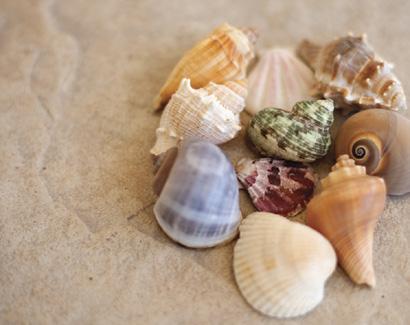
This year, the North Central Florida chapter of the American Cancer Society is aiming high.
All over the country, Relay For Life has been unifying communities against cancer. Alachua County’s local chapter will oversee 21 Relay events in our area in hopes of raising more than $1 million dollars to fund research, advocacy and service initiatives for cancer patients and their families, as well as the community at-large.
Four Relay events were scheduled for May: at Howard Bishop Middle School in East Gainesville on Friday, May 1; at Newberry High School on Friday, May 8; at Hawthorne Recreation Center on Friday, May 15; and at the Southwest YMCA in SW Gainesville, also on May 15. Gainesville-area relays were a great success, but the official numbers had not been calculated by our press time.
“Relay is an opportunity to celebrate survivorship, remember loved ones lost and [it] provides an opportunity for communities to fight back against this dreaded disease,” said executive director of the local chapter of the American Cancer Society Mel Toran.

The annual event is the American Cancer Society’s signature fund raiser and each event is volunteerdriven, from the directors to the teams of relay walkers and runners.
“This allows each community to own the event,” Toran said. “(It) makes it unique to their individual community.”
Relay is an overnight event and team members stay up all night walking or running around a track to raise money. Games and activities also are planned for the center field, which makes it a fun, family event for a good cause.
Money raised goes right back to the community, Toran said. Currently, four multi-year research grants funded by the American Cancer Society are being used at the University of Florida. Local residents use support programs, including “Reach to Recovery” for breast cancer and the “Man-to-Man” program for prostate cancer.
One in three people will be diagnosed with cancer during their lifetime, according to the event’s website (www.relayforlife.org). Besides raising funds, Relay gives patients and those who have been touched by cancer a reason to hope. Every event features a “Survivor Lap” and “Luminary Ceremony,” a candlelight dedication that lights up the event as luminaries are placed around the track to honor survivors and remember those who have lost their battle with cancer.
For more information about the North Central Florida chapter of the American Cancer Society, call (352)376-6866 or visit www.cancer.org.
Owned by Tom and Robin Llinas, Great Southern Music prides itself on being different from the other studios.
From Instrument repairs, rentals and purchases to music lessons, Great Southern Music has everything you need to become a great musician. They have recently added morning and evening Kindermusik classes, taught by Lacey Cupp and Celeste Cragun. Let your little ones learn the joy of music and dance in a fun environment.




This summer is a great time to get your youngster started in music. Call Great Southern Music to find out about summer music camps for preschoolers!
Great Southern Music offers large, quiet lesson rooms in a family-friendly atmosphere. Their instructors are highly-qualified and professional, giving lessons on 14 different instruments, including group violin lessons. Great Southern Music teaches voice lessons and has a fun guitar club. Their students range from 5-85!

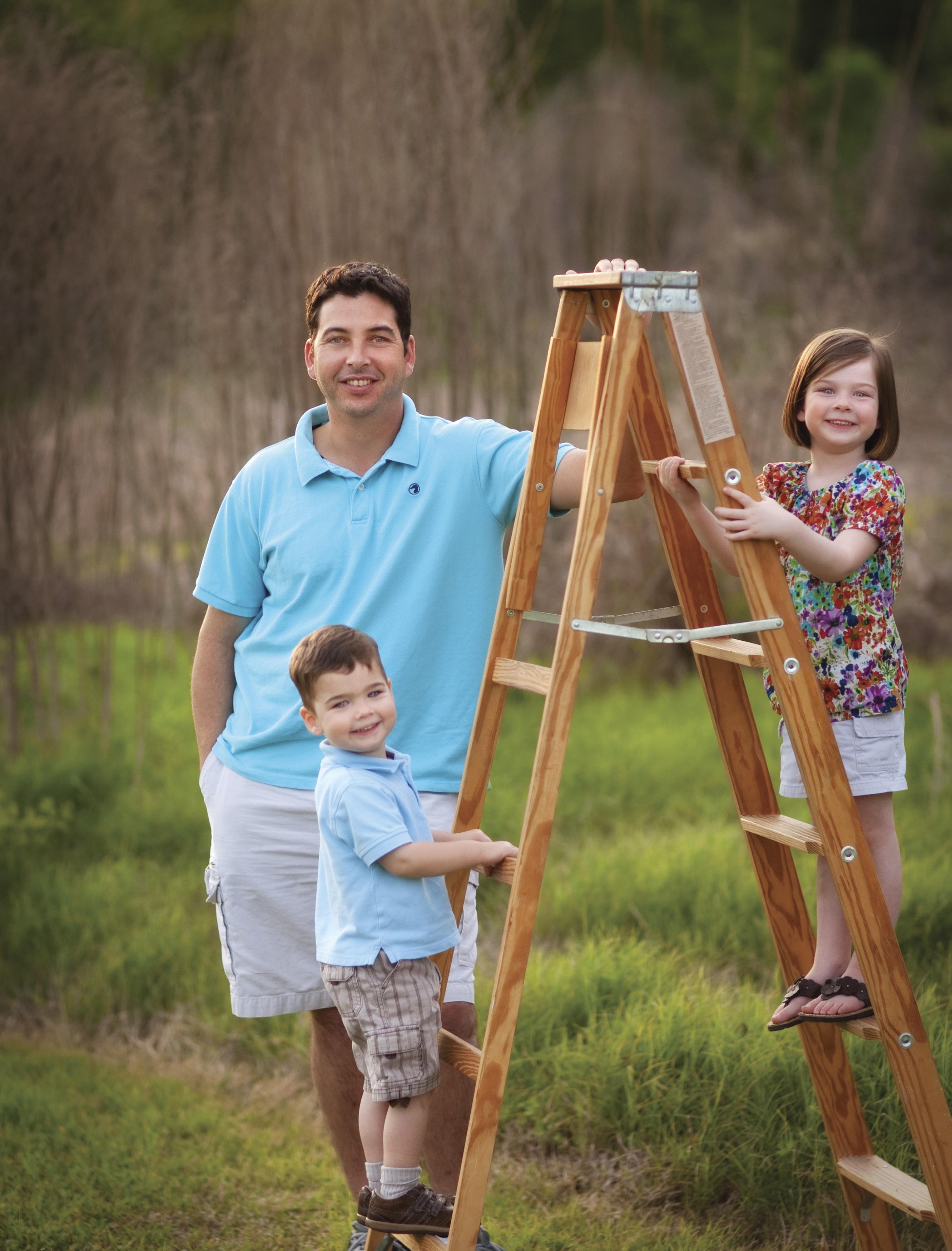
I will love anything my kids give to me for Father’s Day, that is, until they’re old enough to get jobs.
-Chris McSwain with Emma and Liam
anything from them!Photography by The K Gallery
For Father’s Day, I would love to receive something handmade by the kids that describes their love and appreciation for me.
-Chad Marquis with Zeb, Justice, Faith, Luke and Kyler

justa little time!
My best Father’s Day gift would be to get more of the thing I seem to have the least of... time. It would be time that I could spend with my family, on a date with my wife, pursuing my hobbies (home brewing beer), sleeping in, spending time with friends or even taking piano lessons.
-George Perrin with Sean, Conor, and Patrick

Chances are that you have heard of “redshirting.” When you hear the term, you most likely think about collegiate sports. Well, there’s a new sport in town -- Kindergarten! Redshirting is the new term floating around preschools all over the country, as parents try to decide whether to send their children to Kindergarten or hold them back to gain an extra year of maturity.
With registration for the 2009-10 school year under way, parents are becoming more concerned about their decision for this coming August. Unfortunately, it’s not an easy decision.
This phenomenon is not new. Parents across the country have always been concerned about their children entering Kindergarten. They have wondered if their child is ready for the structure and expectations that come along with learning in a new environment. But, recently, those concerned thoughts have been given a name.
There are a lot of different factors that parents should use to determine if a child is ready to enter Kindergarten. First, look at your child’s age, maturity level, ability to follow directions, handle change and deal with separation from home. Try to measure your child’s desire to learn new concepts. Realize that every child is different, in terms of maturity and ability to learn.
• Most parents will assess their child’s age. Although age should not be the sole determining factor in your decision, it is important to consider age when making your decision. The birthday cutoff for Alachua County schools is September 1. Therefore, as long as your child reaches age 5 by August 31, 2009, your child is eligible to begin Kindergarten this fall. Children that are younger when they begin Kindergarten are usually less mature than their older peers. This can cause a significant difference in a child’s ability to focus and follow directions at school, when compared with a child who could be almost a full year older.
• If you are unsure if your child is academically ready for Kindergarten, call your local elementary school and ask them what expectations they have for incoming students. If your child is in preschool, talk with their teacher to see how your child is performing in class. Your child’s teacher should have extensive knowledge of your child’s abilities.


• Consider that an alternative option to redshirting is to have your child repeat Kindergarten, if necessary. Many people believe the best place to prepare for school is in the classroom. Know that you have the option to allow your child the benefit of going to Kindergarten to see how they progress. If you see your child struggling, you can decide to have them repeat Kindergarten. This not only would give your child the benefit of repeating the academics, but it also would give them one more year of maturity to boost selfesteem and academic readiness.
It is a parent’s job to make sure that their child is given every opportunity to succeed in life. This is just one of the many decisions that parents have to make to help their children along the way. b
“an


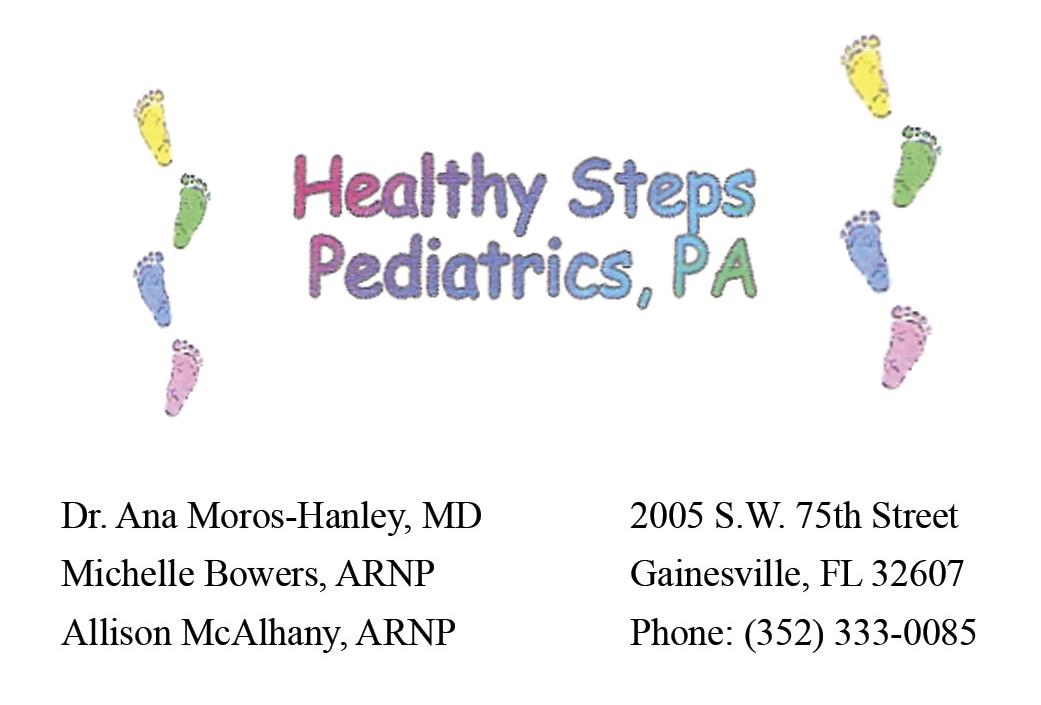


1Never shop on an empty tummy! When you are hungry, you are more likely to stick things in your cart that you want to eat at that moment. Try having a light snack before you go to the store, so that you are more likely to buy what you need.
2Make a list and stick to it. Try to keep your list in one place to avoid creating duplicate lists.
3Plan meals ahead of time with the whole family before you go shopping. Take inventory of what you have and what you will need while making your list. This will take the guess work out of meal planning and get the whole family involved.
4Compare store prices. If you can buy something cheaper at a discount store, then do it! Nobody says you have to shop at just one store. Plan out your shopping route and make sure to take lists and coupons!
5Coupons, coupons, coupons! There are so many great places to find coupons. Cutting coupons is cool and an easy way to save money. Check your local newspaper, store or even on-line. Spend 10 minutes a week to go through your resources. Make it a family affair and give the kiddies a pair of safety kid scissors, some pages of the paper and have them cut away! Try www.coupons.com for printable store coupons. Make sure to have coupons organized in one place, like an envelope, file folder or a simple rubber band. Have them together and in-hand when going to the store.
6Take advantage of store promotions on things you will actually use or need. There is no sense is spending money on things you don’t need or will never use, just because it is on sale or looks like a great deal. Wasted money in the pantry is no deal.
7Buy necessities in bulk, especially nonperishable items. You can never have too many rolls of paper towels.
8Go the healthy route. Packaged snack foods are convenient, but you are paying for that processed food in all that packaging. Try to make your own quick, healthy snacks for lunches and car rides. Try baggies of pretzel sticks, apple slices or homemade trail mix.
9Go local. Try your local farmer’s markets for the best in homegrown fruits and veggies. Because they are local, they don’t have the added markup for delivery charges that some places tack on to the prices. Support local farmers!
10Crush child meltdowns! For parents, it is easy to calm a crying child in the aisle with a $4 box of cookies that are not on your list. Plus, the cookies will spoil the lunch you were planning on making with the groceries. Instead, pack a small backpack for them, filled with healthy snacks, a juice box, a favorite car or doll and a list of their own to scribble on! You will be amazed!
Thereonce was a Kindergarten teacher, who had a little boy in her class named Billy. One day, she made a remark to one of her fellow teachers about how well Billy’s parents got along and how each of them were so involved in Billy’s progress at school. The second teacher was surprised by this because Billy’s parents had been divorced for several years –Billy’s teacher had no idea.
I would be lying if I said that the above story was typical. Unfortunately, when two people are in the process of ending their marriage, it is understandable that most of their energy is focused on how they are feeling and figuring out how they are going to cope with the changing family dynamics; and, as a result, parents often lose sight of how the divorce is affecting the children.
In the above situation, Billy’s parents managed to effectively co-parent, despite having been divorced from each other. They were able to co-parent, despite no longer co-habitating. From the teacher’s perspective, they were equally interested, invested and involved with Billy’s academic and social success. They learned to cooperate with each other in making decisions that shaped their child’s life. The transition was probably not seamless, but it is possible to minimize the effects of divorce on a child.
to Florida Statutes to provide a framework for perspective on being a co-parent.

Last year, the Florida legislature made some changes to the laws affecting dissolution of marriage, parental responsibility and child support. Terms such as “custodial parent,” “noncustodial parent,” “primary residential parent” and “secondary residential parent” have been stricken and are no longer defined. Other words that have been deleted are “primary residence,” “custody” and “visitation.” These concepts have not necessarily been repealed, but rather are encompassed under the framework of a “parenting plan” and “time-sharing arrangement.” One reason for this change is the legislature’s attempt to balance the importance both parents have on minor children and encourage both parents to play a greater role in their children’s lives. The new terms recognize that a parent traditionally referred to as the “secondary” parent plays an equally important role in the life of their children.
Parents have wide latitude in crafting a parenting plan that will work best for their situation. The typical time-sharing schedule specifies the time (including overnights and holidays) a minor child will spend with each parent. Although mostly fashioned by parents, both the parenting plan and time-sharing arrangement are ultimately approved by the Court. Many issues contained in a parenting plan focus on physical, social, emotional and health needs of the child, by taking into account the specific circumstances of the family. A parenting plan is a tool to aid in putting more of a concrete and comprehensive framework to the old concept of “shared parental responsibility,” which is a court-ordered relationship where both parents retain full parental rights and responsibilities with respect to their children. As part of the plan, both parents confer with each other so that major decisions affecting the welfare of the children will be determined jointly.
So, how can we, as a community, support families who are going through a divorce? Both the parents and children will be looking to their existing relationships for support and encouragement. As a community, we can remind parents of the importance of taking care of themselves, all the while being mindful of the need to foster the best possible family relationships and community network for the children.
However, the reality of divorce is that parents will sometimes find it difficult, if not impossible, to have a healthy co-parenting relationship. This can be true regardless of whether the parents are married or divorced. This may be caused by one parent’s difficulty in communicating effectively or simply a refusal by one parent to adhere by the principles of shared parental responsibility. Parents facing the imminent dissolution of their marriage are not alone in figuring out how to co-parent with the best interests of the child in mind. Parents can look
“They learned to cooperate with each other in making decisions that shaped their chid’s life.”




RECIPE SUBMITTED BY STEPHANIE GORDON
Photo by Kelsey Gordon
Stephanie Gordon is a Gainesville resident, who has a passion for all things cupcake. Her signature cupcakes are so delicious and unique that you will never want to reach for the boxed mixes again. These Key Lime cupcakes are inspired by summer days in the Florida Keys. Their ideal blend of tangy and sweet will take you away from the ho-hum of everyday and off to a sweet summer Florida day, with your toes in the sand and the sun on your face.
To discover all the other delicious cupcake confections Stephanie has to offer visit her website at www.Stephaniescupcakes.com or send her an e-mail at Stephaniescupcakes@yahoo.com.
Icing
In a large bowl, beat cream cheese and butter until smooth, about one minute. Once cream cheese mixture is smooth, add lime juice to mixture and beat until combined. Finally, add powdered sugar one cup at a time, beating after the addition of each cup. Once all powdered sugar is added beat for an additional minute, until frosting is smooth and creamy. Cover and refrigerate for at least 1 hour.
Graham Cracker Crust
Chop Graham Crackers in food processor until they are fine crumbs. Melt butter in microwave. Add Graham Crackers to butter and mix with fork, until well combined. Place paper cups into cupcake pan and press 1- 1 ½ Tbsp of crumbs into the bottom of the cup. Set aside.
Cupcakes
Icing
1 8 oz. package cream cheese, softened
1 stick butter, softened
¼ cup lime juice
6 cups powdered sugar
Crust
9 graham crackers
6 Tbs butter
Cupcakes
2 cups all-purpose flour
2 tsp baking powder
½ tsp salt
1 cup (2 sticks) butter, softened
3 eggs at room temperature
1 ½ tsp vanilla extract
¼ cup lime juice
1 ½ cups milk
1 Tbs lime zest
1/8 tsp green food coloring
Preheat oven to 350 degrees. Combine flour, baking powder and salt, set aside. In a large bowl, beat butter until smooth. Add sugar and beat until light and fluffy, approximately 1-2 minutes. Add 3 eggs and vanilla extract to butter mixture and beat just until combined. With mixer on, slowly add lime juice, beating just until combined (mixture may look to be separated, but this is normal). Alternately add the flour mixture and milk to the butter mixture, starting and ending with the flour mixture, and beat until combined. Add lime zest and food coloring to batter, beat until combined, scraping the sides of the bowl.
Pour batter into Graham Cracker crusted paper cups, filling each ¾ full. Bake at 350 degrees for 12-13 minutes, until a toothpick inserted into the center of cupcakes comes out clean. Cool in pan for a minute, then transfer to wire cooling rack and cool completely before icing.
To decorate, get creative! You can add a lime wedge and sprinkle some granulated sugar on top, use summery sprinkles to give them some flare or just leave them as is. It’s completely up to you. However you choose to decorate them, make them your own and enjoy!

On a beautiful Saturday morning, I was happy to attend a friend’s wedding with my one year old, while daddy used the time to catch up on school work. With my clever preparation, the snacks and toys made for a smooth time at the ceremony. We made our way to the reception, ready to celebrate and eat the long-awaited lunch for which our tummies were screaming. The wait for our meal was a little longer than expected, so I allowed my daughter to explore the room and offer her funny ‘hellos’ and silly giggles to the other guests. I continued with my conversation at the table when all of a sudden, I heard some chuckling coming from the surrounding tables.
As my husband and I make dinner in the evening, our two girls (ages 3 and 5), usually entertain themselves in the living room and play until dinner is ready. For the most part, this is an easy, worry-free time. Well, the other day, we were making dinner and into the kitchen walked the three-year-old with blue Sharpie permanent marker all over her face, hands and clothing. We immediately ran into the living room to discover an original work of art right in the middle of the living room floor, which had just been redone with laminate wood only a few months prior! My husband grabbed the closest thing he could find to try to wipe it off -- a tea towel and a bottle of bleach cleaner. But, the “permanent marker” would not come off our floors. Luckily, we found that a little elbow grease and a Mr. Clean “Magic Eraser” took care of the problem right away. Our daughter, on the other hand, stayed blue for a few days.
To my surprise, I look to the floor to find my daughters newly found form of entertainment: my tampons. In utter embarrassment, I turned to the laughing tables and apologized for my daughter’s hilarious discovery! Fortunately, the tables were filled with a few parents, who knew it’s just all a part of the curiosity that teaches our children something new every day!
Ann, mother of one
 Jesse, mother of two girls
Jesse, mother of two girls
“the curiosity that teaches our children something new”
time
look inside our beach section for this summer’s swimming safety and travel tips

we’re headed to the beach!
fun! SummerPhoto by The K Gallery

Located approximately 260 miles south of Gainesville on Florida’s east coast, the city of Jupiter has plenty of family-friendly things to do for kids of all ages. You can visit the sea turtles at Loggerhead Marinelife Center, spend a relaxing day at one of the many beautiful beaches or visit the Jupiter Lighthouse and museum. If you happen to have your golf clubs, Jupiter is home to many award-winning courses for all skill levels. Pet lovers will be happy to hear that dogs are welcome on many of the non-guarded beaches. If sight seeing is your thing, you can take a tour of beautiful Jupiter Island, home to the rich and famous, including Tiger Woods, Celine Dion and Greg Norman. With shopping and dining aplenty, miles of beautiful beaches and historic landmarks, Jupiter is a must-see for everyone.

Check out:
www.marinelife.org
www.jupiterlighthouse.org
www.jupiter.fl.us
is a fun, yet exhausting adventure for all parents. Cut out the stress with our complete check-list!
P Towels
P Sunblock
P Lip balm (with spf)
P Change of clothes for all
P Extra shoes
P Radio
P Cell phone
P Toys, beach balls, pails, shovels, Frisbee, snorkel, fins, goggles, surf boards, boogie boards
P Low salt/low sugar snacks: such as granola bars, orange slices, low salt pretzels, apple slices, cheese sticks, bananas
P Cooler with plenty of water and low sugar juices
P Spray bottle with water
P Baggies for wet clothes
P Baggies for beach treasures
P Hats
P Sunglasses
P Light weight shirts
P Sun umbrella
P Beach chairs
P Watch
Featuring beautiful white sandy beaches and clear Gulf waters, Clearwater is located on Florida’s west coast, about 150 miles south of Gainesville. There are plenty of things to do on Clearwater’s beaches and in the surrounding community. Celebrate sunset nightly at “Sunsets at Pier 60,” a family-friendly event featuring craft and food vendors and talented street performers. Your family can visit Winter, the dolphin with a prosthetic tail, at Clearwater Marine Aquarium. If relaxation is on your mind, pamper yourself at one of the area’s world famous spas. Dad and the kids can partake in one of the many available open water adventures, including spectacular fishing, or take in a Tampa Bay Rays’ baseball game in nearby St. Petersburg. Find enough entertainment for preschoolers on Clearwater’s sandy shores, where your kids can build sand castles, chase beach birds and watch the tiny coquina clams bury themselves in the sand.
Check out: www.floridasbeach.com
www.clearwaterflorida.org
Alachua County residents are probably most experienced with the 70-mile trek to St. Augustine, which is a great locale for a day trip or a weekend getaway. Whether you’re looking for fun in the sun or a history lesson, St. Augustine has plenty for everybody. With miles of gorgeous coastline for beach activity, you’ll enjoy the laid back atmosphere. Cars can gain access to the beach (usually for a $6 daily fee), but personal watercraft have to be launched from a ramp. If you’re a shopaholic, a foodie or a history buff, you will not be at a loss for things to do in downtown St. Augustine. The history of the town dates back to the 1500s and historical attractions include the Castillo de San Marcos, the Oldest House, the Mission of Nombre de Dios or any of the city’s fascinating museums.
Check out:
www.staugustinehistoricalsociety.org
www.oldcity.com
Beach safety is very important! Follow our SAFETY CHECK LIST to guarantee a safe and fun time at the beach!

1. Know your surroundings. Never leave valuables unattended!
2. Always swim where there is a life guard! A guarded beach is a safe beach!
4. Know your flags. Between rip currents and sea lice, there is a flag for everything. Check the lifeguard’s board upon arrival.
5. Watch where you walk! Sea creatures do not always stay underwater. Keep an eye out for jelly fish, crabs, snails, sand fleas and sharp shells or rocks in the sand. Do not touch washed up animals and contact the life guard if you are in danger!
6. The Florida sun can be dangerous, especially when you have been in the water. Make sure you re-apply sun block to yourself and children each time you get out of the water.
7. The sand is on fire. The sun can heat beach sand to amazingly hot temperatures. DO NOT let children walk on sand without shoes. Their feet are sensitive and can burn within short distance back to the car. Same goes for Mom and Dad!
8. Re-hydrate! Make sure to stay hydrated with fresh water. The ocean’s salt water can leave you dehydrated and parched!
9. Sea lice, also known as sea bather’s eruption, appear from March to July. According to the website www.lantana.org, the exact cause of sea lice is not known, but research has suggested it is the larval form of the thimble jellyfish. Known for making you itch in places you don’t want to itch, the “sea lice” gets trapped in bathing suits and, as you walk around, they sting releasing toxins that cause burning, itching and irritation. To protect yourself and children, apply Vaseline or barrier creams to your skin and once out of the water, remove bathing clothes and shower immediately!
10. Watch for sharp objects in the water! Soft sand and the beautiful water can be deceiving. Shells, rocks, and broken bottles all can be found in the water. Invest in some water shoes for the entire family.


tion of skills that will foster a lifelong love of the water.
“In this economy parents have to decide what’s most important and swim lessons are,” Wilby said. “Our motto is to ‘Give your child a lesson for life.’”
Lessons with Swim America start at age three and progress gradually based upon each child’s ability. Preschoolage children should learn basic survival skills, like the “roll over” technique, and then learn to swim to the wall.
BY MARY REICHARDTFrom beautiful beaches to backyard pools, the best way to beat the heat is in the water. With so much fun to be had swimming, it’s easy to forget how dangerous it can be.
According to the Center for Disease Control and Prevention (CDC) website (www.cdc.gov), fatal drowning is the second leading cause of unintentional injury-related death for ages 1-14. Nonfatal drowning also can result in serious and permanent injury.

Just two years ago, a local family, who wishes to remain anonymous, had a near-tragic incident with their young daughter. The youngster suddenly slipped into a friend’s pool and silently began to drown. Her parents were busy tending to another child and, within seconds, their daughter was unconscious in the pool.
“She had taken two summers of swim lessons,” said her mother. “But, you can never think your child is a great swimmer with just a few lessons.”
The girl was revived by her father, who was trained in CPR. She sustained no lasting injury or trauma. Both parents still are firm believers in swim lessons and understand that learning how to swim is a slow process.
“Even if your child is afraid or apprehensive, you should still challenge them with lessons, because we live in Florida and they will be exposed to the water at some point,” said her mother.
According to the CDC, three children die every day as a result of drowning. The American Red Cross North Central Florida Chapter offers CPR classes in Gainesville, at the end of which you can be certified for infant and adult CPR and other safety training.
“This training is an important skill to know and our classes offer lots of visual and hands-on training that is repetitive, so you can act quickly should a crisis arise,” said health and safety director of the American Red Cross North Central Florida Chapter Terri Keith.
Jill Wilby is a long-time swim instructor with Swim America, part of the Gator Swim Club, whose philosophy is to promote awareness and water safety by giving each swimmer a founda-
However, these techniques cannot replace a watchful eye and close parental supervision. The American Academy of Pediatrics (AAP) suggests practicing “touch supervision” with children under age five, which means an adult is always within an arm’s reach of a swimming child. The AAP also stresses the importance of pool fencing to create a solid barrier for wandering children. More safety tips can be found on their web site (www.aap.org/family/ tippool).
“The most important thing children need to get out of swim lessons is a love for the water,” said Carrie Reichardt of Team Reichardt Swimming. “Learning to swim comes so much faster once you have that love.”
She and her husband Jack have been co-teaching swim lessons in Gainesville since 1981.
“It’s a great advantage teaching with your spouse, because we know each other and have the same goals,” said Jack. “We complement each other. Where one is weak, the other is strong and that promotes great confidence in us, which then translates to our students.”
Swimming lessons, proper pool equipment and first-aid training are all a big part of swim safety. But, the most important aspect of swim protection is you. Make your swimming a family affair.
For information about CPR and other safety classes by the American Red Cross, visit www.redcrossncfc.org or call Terri Keith at 352-376-4669.
Your pool barrier...
P Must be at least 4 feet high on the outside
P May not have any gaps or openings that could allow a child to squeeze under, through or crawl over the barrier
P Must be sufficiently away from the water’s edge
P Must be situated away from anything that could be used to climb over the barrier
Gates around pools must open outward, be self-closing and have a self-locking mechanism
For more information go to www.leg.state.fl.us
With summer fast approaching, it’s time to head outdoors to enjoy the beautiful Florida sunshine. Unfortunately, fun in the sun carries some important health risks. Skin cancer is the most common cancer in the United States and skin cancer rates are increasing.
Children are especially vulnerable to the harsh rays of the sun. Did you know that just a few childhood sunburns could dramatically increase your child’s risk of developing skin cancer? So, it is very important that we protect children and teach them about sun safety at an early age.
According to the American Academy of Dermatology, melanoma is the second most common cancer for ages 1529. While melanoma occurs in only seven per one million children, its rate has more than doubled in the past decade. It also is important to protect children from damaging UV rays, because as few as five sunburns in a person’s life can double the risk of melanoma.
Sunscreen is the first line of defense against the sun’s damaging ultraviolet (UV) rays. However, a trip to the sunscreen aisle can be frustrating because of all the choices available to the consumer.
Keeping a few guidelines in mind should help you choose the right sunscreen. First, choose a quality brand of sunscreen, which offers broad UV protection with a Sun Protection Factor (SPF) of at least 30. Stick to the least irritating sunscreens, which contain titanium or zinc-based ingredients designed for sensitive skin. Consider sunscreens with newer technology that extend the time the sunscreen is active on the skin. It also is very important to check the expiration date on the bottle, since sunscreens lose their effectiveness after expiration.
Applying sunscreen correctly is just as important as choosing the right sunscreen. Start by applying a heavy coat of sunscreen to any exposed areas of skin. Pay close attention to your face, ears, and neck. It is best to apply sunscreen before putting on clothing to ensure a more even application. When you think you have applied enough sunscreen, apply a second coat. Studies have shown that most Americans use only half as much sunscreen as it takes to get the full SPF stated on the bottle. You need to use one ounce of sunscreen or enough to fill a shot glass to cover an average adult body. Be sure to apply your sunscreen 30 minutes prior to going outside to allow it to soak in well. Once you’re outside, don’t forget to reapply sunscreen at least every 2-3 hours or after excessive sweating or swimming.
Sunscreen is safe to apply to children older than 6 months. While applying sunscreen to children younger than six months likely poses no significant health risks, no formal testing has been performed. A good rule is to keep children covered and protected from any sun prior to 6 months and to avoid sunscreen, as newborn skin is particularly prone to irritation.
Sunscreen is not the only defense against the harmful rays of the sun. Wide-brimmed hats, sunglasses and protective clothes are equally important. If children get accustomed to wearing a hat and other protective items, perhaps they will develop this good habit for life.
It is also best to enjoy outside activities when the rays are not as harsh. Seek shade between 10 a.m.-2 p.m., when the sun’s rays are most harmful.
It is not necessary to avoid the beautiful Florida sunshine. With a few simple precautions, it is possible to enjoy all of your outdoor activities in the sun safely.
 -Miranda Whitmer, MD Board Certified Dermatologist Gainesville Dermatology
-Miranda Whitmer, MD Board Certified Dermatologist Gainesville Dermatology

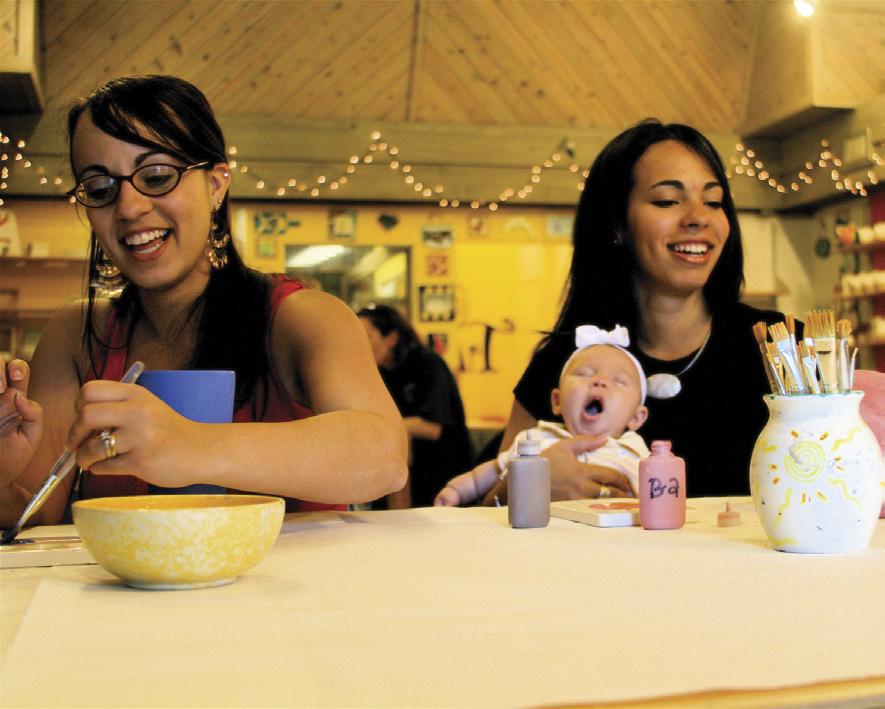
hat better way to wind down from a long day of work, kids, laundry and diapers, than to relax with some friends at your local art studio for a night of creativity and laughter. This month, Nicole, Leslie, Alison (not pictured), Mary and baby Kailey traveled to Do Art, in Thornebrook Village to let their creative juices flow. .pidatat non proident, s
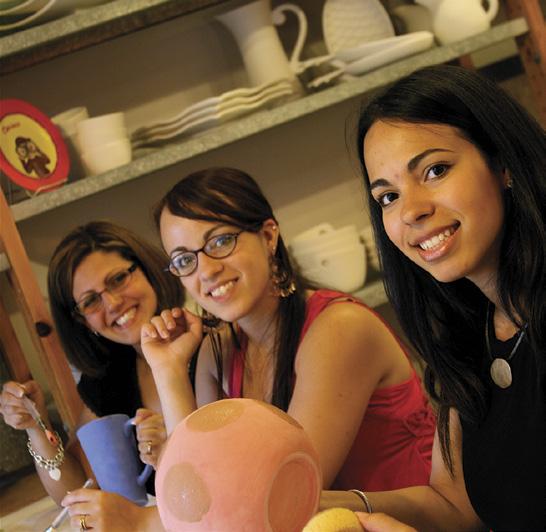
The best and hardest part was choosing from the many pieces of pottery. After putting down the piggy banks, vases and saltshakers, we finally decided on a cookie jar, a mug and a platter. Stay tuned to see our final pieces.
for all your art needs.


Even the youngest member of our LNO had a relaxing evening.
 The studio is filled with pottery, mosaics, glazes, brushes and sponges
The studio is filled with pottery, mosaics, glazes, brushes and sponges

Q: We have two sons, ages 3 and 5. They go to sleep in their own beds at night, but they usually jump into bed with me and my husband in the early morning hours. When we ask them why they come to our room, the youngest boy says he is scared in his room. His brother says our bed has warmer blankets. How can we get them to stay in their own beds?
A: There are many different opinions out there regarding children sleeping in their parents’ beds and it is important to recognize that co-sleeping is not always bad thing. It brings security and comfort to your children.
Meredith Small, a professor of cultural anthropology at Cornell University and author of “Our Babies, Ourselves; How Biology and Culture Shape the Way We Parent,” (Anchor Books, Doubleday) explains that co-sleeping is accepted differently in different cultures. She believes it is natural for young children to want to sleep in bed with their parents. She also explains that in some countries, such as Japan, children can sleep with their parents until they are teenagers. In western society, co-sleeping is frowned upon. The western culture believes in more childhood independence.
No matter whose opinion you agree with, co-sleeping also can bring a lack of closeness and intimacy between you and your husband. What I am interpreting from your question is that you would like your boys to remain in their own beds all night.

There are several different techniques you can use to help your children stay in their beds. As for your youngest son, you need to address the issue of what scares him. Ask him what would help him feel more safe and secure. Explain to him that you are there to help him feel secure and that you will do everything you can to help him feel safe at night. Then, create a plan with his help. What is scaring him will determine what your plan should be. It could mean that you plan on checking on him every half-hour until you go to bed. You also might leave his door open, leave a night light on or leave “monster spray” in his room to help keep the “monsters” out (fill a spray bottle with water to mist the monsters away!).
Your oldest son is obviously more comfortable cuddling with Mom and Dad. He probably sees your youngest son in your bed and doesn’t want to miss out on anything. Make sleeping in his room a game, which you should do with both boys. Have a sleeping chart that you fill with stickers to watch his progress. Once he reaches a certain amount of nights in bed until morning, allow him to purchase something at the local dollar store. Start a countdown or purchase special alarm clocks for your sons. When the alarm goes off, they are allowed to come to your room in the morning.
Another idea that may help your boys stay in their room at night is to decorate their beds with a special theme. Make their beds a place where sports stars or super heroes sleep. In the case of a girl, a princess theme would work well. Use a monitor or walkie-talkie set to encourage your children to stay in their beds. Allow the kids to contact you if they are scared or need you by using the walkie-talkies. At first, you may hear from them several times a night - don’t discourage this! By the end of the week, they should be using the walkie-talkie much less! Give a reward in the morning if you did not hear from them.
Remain consistent and once you set a schedule, stick with it. Understand that this stage in their life is not going to last forever. You will, one day, miss the days when your two boys want to cuddle with Mommy and Daddy in the morning. b
have a parenting question?
Contact Wendy at advice@irvingpublications.com


 BY TIFFANI AMO
BY TIFFANI AMO
Ethan Gutter is only 5 years old, but he already is learning how to budget his piggy bank. Using four separate slots, Ethan divides his chore money and loose change into spending money, savings, investments and charitable donations.
This might sound complicated for a five-year-old. But, when your father is University of Florida financial management state specialist Michael S. Gutter, it becomes a natural part of growing up.
Gutter, whose research and expertise involves examining how socioeconomic status, financial education, personal psychology and financial socialization are related to financial behaviors, said teaching Ethan what happens to his money when it goes into each slot is a good way to help the youngster understand why mom and dad can’t always buy him a new toy at the store.
Gutter’s publication includes several suggestions for doing things as a family for less money, ranging from bike rides, hiking and picnics to cooking dinner, which has become a major source of entertainment for the Gutter family. Gutter said that although it takes a lot longer to cook dinner with the help of a five-year-old, it’s also a lot more fun.
“Most parents don’t get a lot of time with their kids in the evening,” Gutter said. “But, before you know it, you’ve had two hours of family time.”
Gutter even spent this past Valentine’s Day cooking dinner with his family. Ethan chose a Planet Hollywood recipe for Captain Crunch Chicken, which kept him busy smashing pieces of Captain Crunch cereal with a metal ice cream scoop for 25 minutes. Gutter and his wife Jessica then cooked a corn and crab chowder with Ethan by throwing the ingredients across the room into a crock pot.
“It might not have been the most nutritious meal and a lot of things ended up on the floor, but it was a great experience,” Gutter said. “I got to know my kid on a different level.”
But even though Gutter’s publication provides good advice for creating a family spending plan and how to monitor resources, Gutter said that many people go about making changes in the wrong way.

“We urge people to make changes in small increments, one to two things at a time,” Gutter said. “Not all at once.”
According to Gutter, the biggest problem in making financial changes is a lack of communication between family members, not just spouse-to-spouse but parent- to-child. Gutter’s publication features sections for parents and for adults living with their parents, as well as for teens.
The publication provides advice for keeping lines of communication open and honest, in order to prevent and to relieve stressful situations.
“Children don’t know what’s going on in the economy,” Gutter said. “What they do know is that mom and dad are upset and we need to be able to tell them why.”
Gutter recently led a UF development team in the creation of “Managing in Tough Times,” a publication designed to help families manage their budgets and their stress. Specialists, in fields ranging from psychology to nutrition, provided their expertise in each particular area of the publication.
But, the ideas in the publication aren’t just good in theory. In fact, Gutter has applied many of them to his own family life.
“We’re practicing what I’m preaching,” Gutter said. “Because of it, our budget is becoming more comfortable and less of a struggle.”
Gutter believes that the best way to manage a budget is to ensure that the entire family understands its economic situation.
“If people don’t learn to manage the stress and maintain it, it will reflect on their family life,” Gutter said.
For more information about “Managing in Tough Times,” visit www.solutionsforyourlife.com. b
“If people don’t learn to manage the stress and maintain it, it will reflect on their family life.”
It is summertime in Florida! Here comes the rain! We know we need the showers in order to keep our lawns green, but if you have little ones at home rainy days can become frustrating!
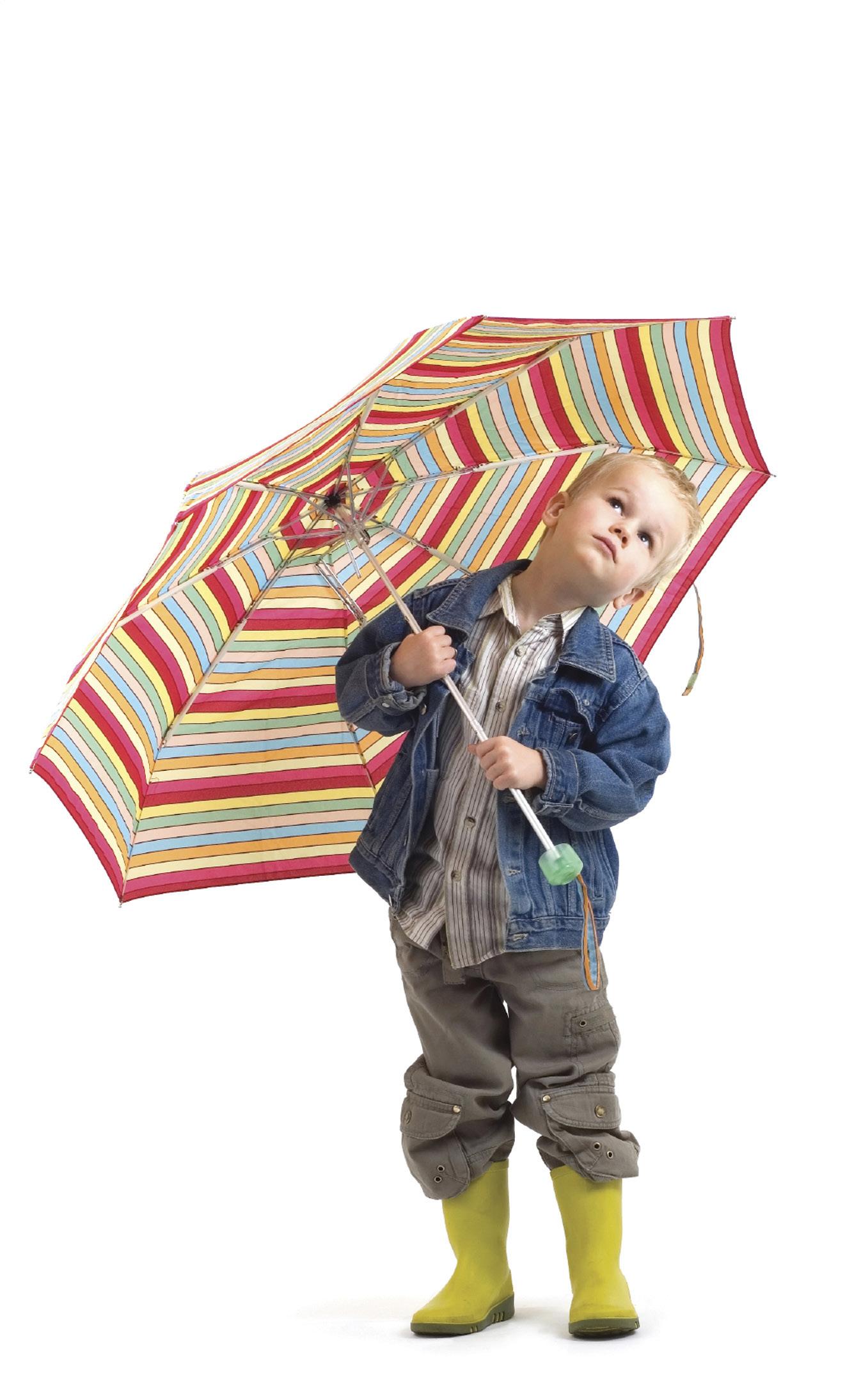
Books, puzzles and DVDs can only entertain for so long. Here are some fun rainy day activities to keep you and your kiddos from getting stir crazy!
1Turn your house into a giant fort! Get out those sheets and move the furniture. Connect the rooms with sheet tunnels so you have to crawl from room to room. You can even serve lunch picnicstyle in one of the fort’s “rooms.”
2Turn your garage into an art studio! Move your car. Bring out all the arts and crafts materials you dread using because of the mess and let the kids go to town! Set up the easel, lay down newspaper, get out the paints and glitter (that’s right, glitter!) and have fun.
3Go garden-tub swimming! Put on their bathing suits and let them jump in! Throw in some bath toys, water crayons and Barbie dolls and let them enjoy! This is also a great time to give them Popsicles (who cares where it drips!) and let them use those messy bubble wands!
4Have some kitchen fun! Get out those “Mommy & Me” cookbooks (or, for the bravest parents, let kids create their own recipes) and make cookies, smoothies, pizza or even homemade play dough. Use vegetable dye to make the play dough different colors. Let the children play with the play dough for another activity after you’re done in the kitchen!
5Take out all those board games and organize a board game tournament! Play several rounds of each game to crown the champion of that game. Make sure you play games at different age/skill levels, so everyone has a fair chance and everyone has fun! You can use your rainy day arts and crafts studio in the garage to make awards for the winner of each tournament.
6Make your own movie! Help your children write the script, paint some scenery, dress-up as the characters, grab the video camera and yell “action!” Not only is this one time-consuming, but the end result will be a great memento of Summer 2009.
Day
our community’s life-saving answers for every age!










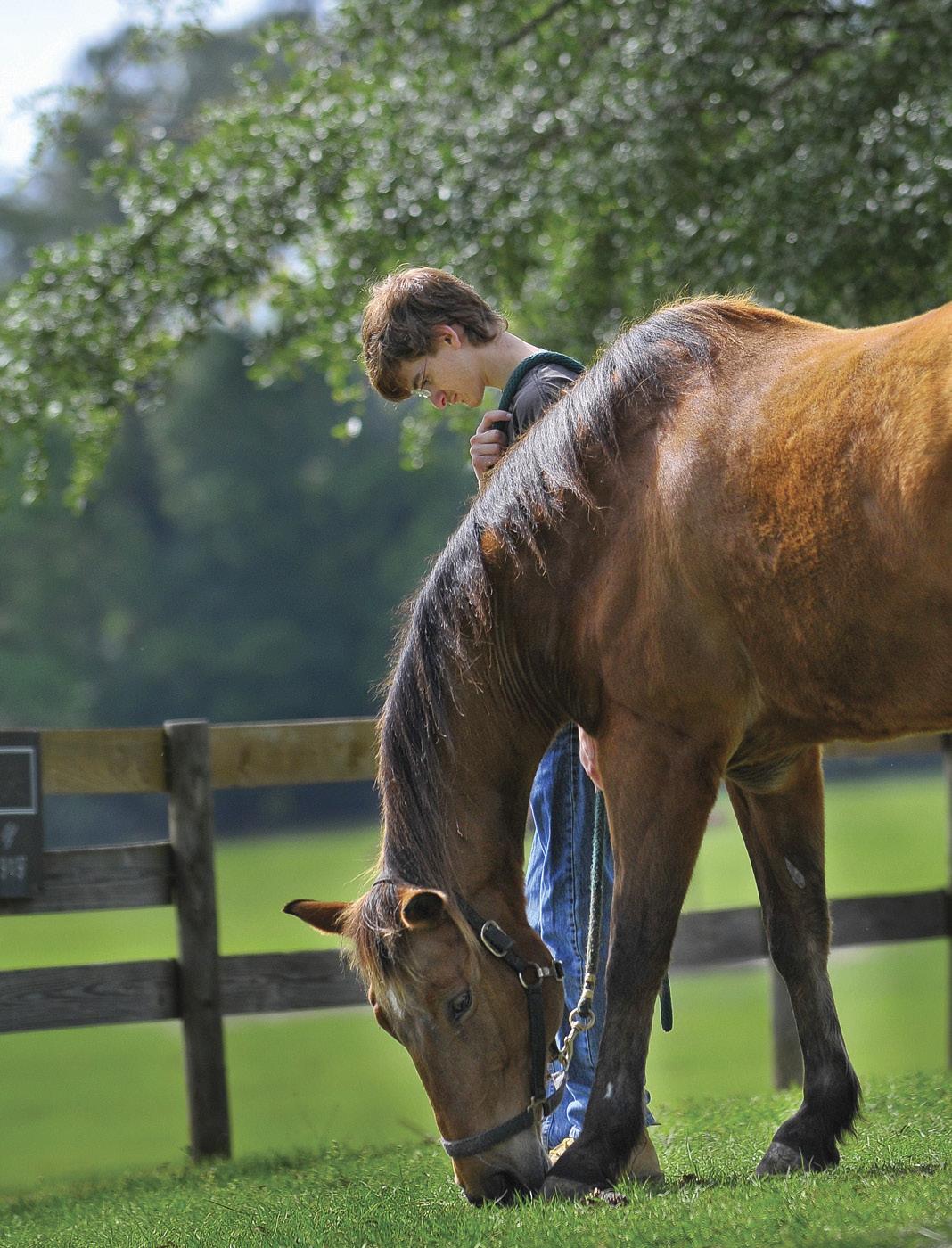 BY SARA POWELL
BY SARA POWELL
With a dog named Brutus resting comfortably between my legs, Peter Gregory and I traverse the hills of Mill Creek Farm on a golf cart. Brutus seems to lose interest after awhile, so he takes to running next to the golf cart as Peter and I chat.
Mill Creek Farm is a retirement home for horses, located on 265 acres in Alachua. Peter seems unfazed by Brutus or the farm’s other 11 dogs, which pop seemingly out of nowhere. The dogs jump on my lap, as their owner shows me around the land where he lives and works.
Peter, 81, can list the name, ailments and back story of nearly all 121 horses, which come from a variety of places. Some, like Dewey, have served as police horses, while others, like Blanket, were found abandoned in the Everglades. Peter says hello to a few of them, each time expressing regret that he forgot to bring them carrots.
“Oh, these poor guys,” he said, laughing.
Peter and his wife Mary, 76, came to Alachua in 1983 and founded the farm in 1984. Both born in London, the couple also lived in Canada, the Bahamas, Portugal, Jamaica and south Florida. Next May, they will have been married fifty-five years. They have three grown children, who live in California and south Florida.
“Mary and I are both huge animal lovers,” he said. “We’ve always had that in common.”
As we zipped along on the golf cart, Peter rattled off stories about the place with ease, pausing a few times to ask me some questions (“Do you eat hamburgers? I don’t think you would if you knew what they did to the animals”).
He makes me instantly comfortable, and I get the sense that he’s well-accustomed to answering questions about the farm. It has received significant media coverage since its onset. In 1994, “CBS Sunday Morning” did a special on the farm, and Jack Hanna from Animal Planet also has given it coverage.
the distance – it’s very peaceful.”
It may sound like a tranquil lifestyle, but the Gregorys put in plenty of hard work. Peter admits he and Mary accidentally “skipped” last Christmas.
Despite the fanfare, Peter and Mary lead selfdescribed frugal lives in their small house on the farm, near the now dried-up Mill Creek. He stops the golf cart behind the house and allows me to admire its simple, but beautiful tranquility. Peter said the two haven’t gone out to dinner since 1993, but he wouldn’t want it any other way.
“My wife is a wonderful cook,” he said. “We eat in our house with our dogs around us, horses in
“Taking care of these horses is a seven-day-aweek job,” he said. “We had to feed them all, make sure they all had water. Before we knew it, we’d missed Christmas dinner.”
His obvious love for animals shines through with stories like these. Peter was successful in the hotel industry before coming to Alachua and he used the money he had made to create the haven for horses.
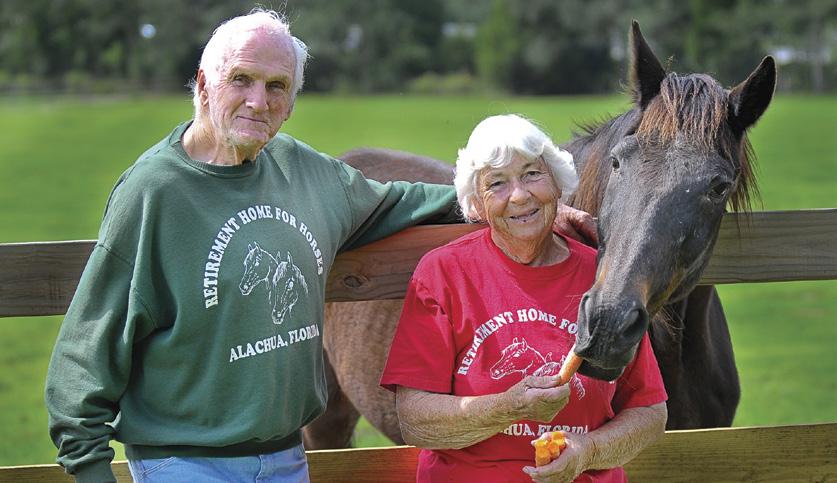
It costs about $275,000 a year to run the farm, which Peter admits has drained the Gregorys’ retirement fund. The farm relies on donations. The Gregorys also have protected the horses’ futures by donating the land to the non-profit agency Retirement Home for Horses, Inc., which has lifetime tenancy.

“This land doesn’t get passed on to our family,” Peter said. “It belongs to the animals.”
We’ve stopped the golf cart outside the farm’s office, where Mary and some volunteers are busy grooming the horses.
Two of the volunteers, Hal and Linda Cohen of High Springs, approach me to express how much they love volunteering at Mill Creek.
“We’ve been coming for two years,” Linda said. “They’re just such nice people.”
Peter said he and Mary love having the volunteers, who are unpaid, come on Thursdays. The farm also is open to the public on Saturdays from 11 a.m.-3 p.m. (admission is two carrots). It seems, though, that Peter and Mary wouldn’t mind just keeping the company of the horses and other animals.
“My wife likes to say, ‘if you have four legs, you’ll do well here,’” Peter said. b
Mill Creek Farm is located about three miles from U.S. 441 on C.R. 235A in Alachua. For more information, call 386-462-1001 or visit www.millcreekfarm.org.


The physical act of speaking – speech – is an extremely complex task, requiring fine motor control of more than 100 muscles in your mouth, face and neck. Each word requires a different configuration of most of these muscles, so it’s no wonder the average child takes about two years to speak. Baby sign language bridges this gap between your baby’s ability to understand the world and her ability to communicate to the world.

Just because she isn’t able to communicate with you verbally, it does not mean her brain is not “on” and working. With sign language, she is able to use the larger muscles in her hands and arms to communicate with you, until those fine motor muscles used for speech have become more fully developed. By using baby sign language, you are taking advantage of your baby’s ability to learn and communicate, even though she’s unable to verbalize words yet.
There are many positive effects when you as a parent or caregiver are able to communicate effectively with your child from the earliest age. Using sign language with your infant or toddler allows you to begin communication many months ahead of verbal communication. You also are able to reinforce
The sign for MILK is made by opening and closing your hand (i.e. imagine milking a cow) and it is the perfect introductory sign, because it’s an easy one for your baby to make. Since babies drink milk so often during the first year of life, you are provided with numerous teachable moments every single day. Remember these three keys to success when introducing your first sign:
• Be consistent – use the sign frequently throughout the day, whenever a teachable moment presents itself.
• Never sign in silence - always speak the word along with doing the sign.
• Reinforce the meaning of the sign (i.e. give your baby milk immediately after saying/signing the word)
There are numerous books and resources available to learn baby sign language that can be found by doing a simple internet search. I recommend books that specifically use ASL and have clear pictures, with descriptions on how to make each sign (such as “Teach Your Tot to Sign: A Parents’ Guide to American Sign Language,” by Stacy A. Thompson).
what she learns by adopting positive interaction strategies, such as following your child’s focus of interest, making eye contact, speaking slowly and using key words. One sign can quickly lead to two, two signs to four, four to eight and so forth. Additionally, you will get many great benefits by communicating earlier with your baby, including:

• Establishing a strong bond with your child early on.
• Greatly reducing or eliminating tantrums and frustrations because your baby is able to communicate her wants and needs clearly (i.e., You know she wants ‘JUICE’ rather than ‘MILK’).
• Learning to read at an earlier age. Research clearly shows that babies who sign also learn to read earlier, speak sooner and have larger vocabularies and higher IQs.
A good time to start introducing sign language to your baby is when she is 6-8 months old. I recommend using American Sign Language (ASL), because everyone who comes into contact with your child can use the same signs. ASL is a language in its own right, so any signs used by your child can then be understood by those who know that sign system.
I also recommend using songs with sign language as a fun way to learn new signs (such as “Pick Me Up! Fun Songs for Learning Signs,” by Sign 2 Me) and using signs while looking at picture books (such as the “Priddy” books).
Personally, baby sign has been an extremely rewarding experience for me, with each of my daughters (ages 1 and 3). It has opened a line of communication between us that I had never imagined possible at such an early age. My goal is for parents and caregivers to learn about the benefits and experience the joy of using sign language with their babies. b
Karianne Wilkins is a licensed Speech-Language Pathologist with more than 10 years of experience in early education and development. She is owner of Earlybird Education, LLC which offers courses in baby sign language and early education.
She can be reached for questions and comments at Karianne@EarlybirdEducation.net or on her blog at www.earlytolearn.com.




Orlando, FL
With thrilling rides, mystical shows and up-close animal encounters, SeaWorld Orlando may just be the right choice for your family’s next day trip.

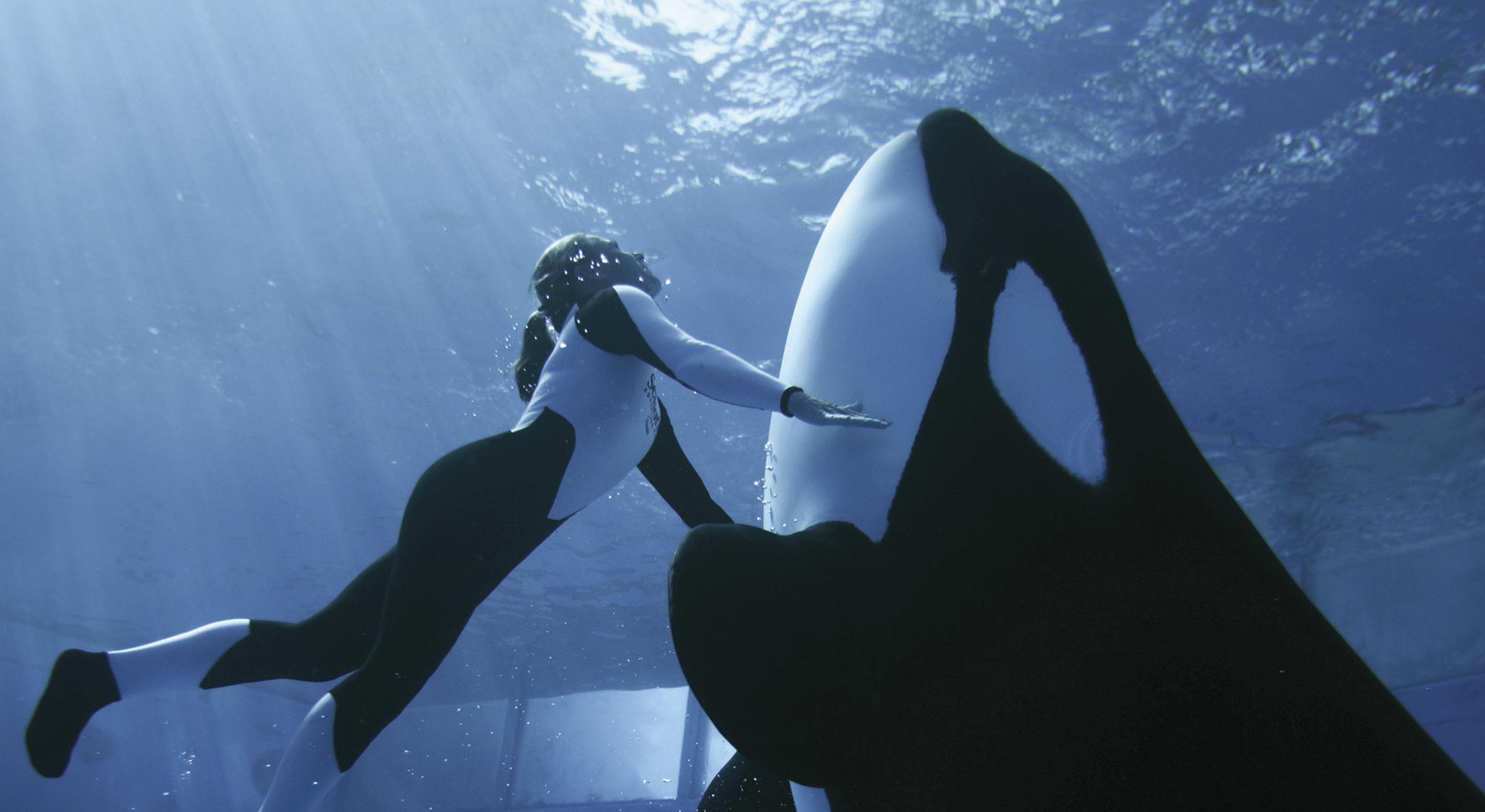
A park symbolized by the killer whale Shamu, SeaWorld gives guests the opportunity to experience “Believe,” a fascinating and visually-dazzling Shamu show, which mixes exciting new killer whale behaviors with choreography. The show emphasizes the special relationship that SeaWorld trainers enjoy with the whales.

Another remarkable show, “Shamu Rocks,” combines spontaneous killer whale behaviors with rock ‘n’ roll music for a high-energy show that’s fun for the whole family. The show is seasonal and performed at night.
Perfect for children, the “Elmo and Abby Cadabby’s Treasure Hunt” show follows the members of the Sesame Street gang in their search for treasure.
“Blue Horizons” is a magnificent show, which combines flipping dolphins, soaring exotic birds and talented acrobats. This theatrical performance showcases divers and aerialists in colorful costumes.
SeaWorld also is a learning experience. Animal attractions can be found throughout the park, all of which educate guests about creatures from the sea. From turtles to polar bears, beluga whales to sea lions, SeaWorld will introduce your family to many unique animals.
SeaWorld also gives guests up-close encounters with sharks, dolphins, penguins, manatees, harbor seals and other sea creatures. You can even have your picture taken with Clydesdales, the world-famous Budweiser horses.
At Key West at SeaWorld, guests are allowed to touch dolphins and stingrays. You can even feed them for an additional fee. With a tropical lagoon and a breezy beach, this area closely resembles the sunny, fun feel of the country’s southernmost city. The animals can even be watched from an underwater viewing area.
As part of Key West at SeaWorld, Stingray Lagoon has as many as 200 stingrays gliding through the water at any given time. Guitarfish, cousin to the stingray, also inhabit the lagoon.

a wet adventure just a drive
The Milton family found themselves at the Stingray Lagoon three separate times on their visit to the park. Andrew, age 5, and Abbi, age 9, could not stay away; they said it was their favorite place.
“Yeah!” Andrew screamed as he reached over and touched a stingray, turning around with a smile on his face.
“I could be here for hours,” Abbi said. She added that she liked the “soft” feel of the stingrays.
SeaWorld also has a wild side. It is home to some bloodtingling rides, including “Journey to Atlantis,” a water roller coaster guaranteed to get you soaked and make your heart drop; “Wild Arctic,” a simulation ride allowing you to explore the Arctic and its amazing animals; and “Kraken,” Orlando’s tallest roller coaster, which soars more than 140 feet above the ground at 65 mph.
Kraken was Tinna Sullivan’s first roller coaster experience. As she strutted toward the rest of her family with her daughter, Shana Thomson, age 16, just after her first ride, she raised her hands in the air and shouted, “I did it!”
months, cried every time his mother removed him from the water that was shooting out of tiny holes in the otherwise hot concrete ground. Rocío, age 6, and Cami, age 3, were off exploring the four-story fortress. Grandmother Sandy Darrington, who sat in the shade several feet away, said they were all having a great time.
There are little surprises around every corner at SeaWorld. Get your caricature drawn. Get your hair wrapped. Play carnival games. Find real pearls in real oysters. Jump on a trampoline. Get a henna tattoo.
For a one day visit, SeaWorld costs $74.95 for adults and $64.95 for children ages 3 to 9. Children under age 3 can enter for free. With the purchase of a single-day ticket, Florida residents will have unlimited admission into the park until December 31, 2009.
Guests can bring their own strollers into SeaWorld or rent one once inside the park. Stroller prices are about $13 for a single and $18 for a double. Lockers also are available for $6-$8.
SeaWorld offers several unique dining experiences, including a behind-the-scenes buffet at the killer whale habitat and a private breakfast buffet with Elmo and his friends.
Guests are welcome to bring in their own food and drinks, which might not be a bad idea. Although the park has nine restaurants, all offering tasty treats and fun atmospheres, meals can get a little pricey.
For more information, visit www.seaworldorlando.com.
“It’s been a great day all the way around,” Sullivan said, after taking a seat in the shade.
Another thrill ride will soon be added to the SeaWorld family. Opening Memorial Day weekend, the roller coaster “Manta” will immerse riders in an underwater world of hundreds of rays and other striking sea creatures.

Shamu’s Happy Harbor serves as a children’s play area within SeaWorld. It is home to the “Shamu Express,” a familyoriented roller coaster, and three other exhilarating rides for children. This area also provides fun for the littlest kids, with four colorful floors of twisting tunnels, nets, slithering slides and a winding water maze.
Adults have not been forgotten. Nearby, shaded tables and chairs await exhausted parents, who are looking to get off their feet and out of the heat. Parents also have the option to crawl, jump and climb with the children, if they have the energy to do so.
This past March, the Darrington family spent most of their SeaWorld visit at Shamu’s Happy Harbor. Thomas, age 18
Moms! Get stacked up and ensure a pleasant day with the kids! Don’t forget to bring:
• small entertainment for wait times-stickers to keep the little ones amused when it’s time to wait in line for shuttles and rides.
• keep them clean and hydrated with sippy cups, wipes, change of clothes.
• did you know you can bring your own packed lunch into the park? Pack light and healthy snacks along with animal healthy containers! (no glass or plastic straws)
• don’t forget your sunblock, hats, and sunglasses.
• bring a towel and bags for the wet clothes
• snacks, snacks, snacks!
As a family of four residing in Newberry for three years, we have become accustomed to the feel of a small community surrounded by a larger picture. My husband Jason is an emergency room resident and spends most of his days at Shands, so we know Archer Rd. like the back of our hands. I stay home with our two children and the three of us have ventured up and down Newberry Rd. too many times to count. We love our routes; we love our routines; and, mostly, we love when we get to spend our time as a family of four venturing to new places in Gainesville or the surrounding areas.

We have met wonderful people and families through the YMCA tee-ball and soccer programs and at The Rock School (where our son attends). We also have become members of Queen of Peace Catholic Church. We have been amazed at how intertwined each of these communities and the opportunities offered by each can be.
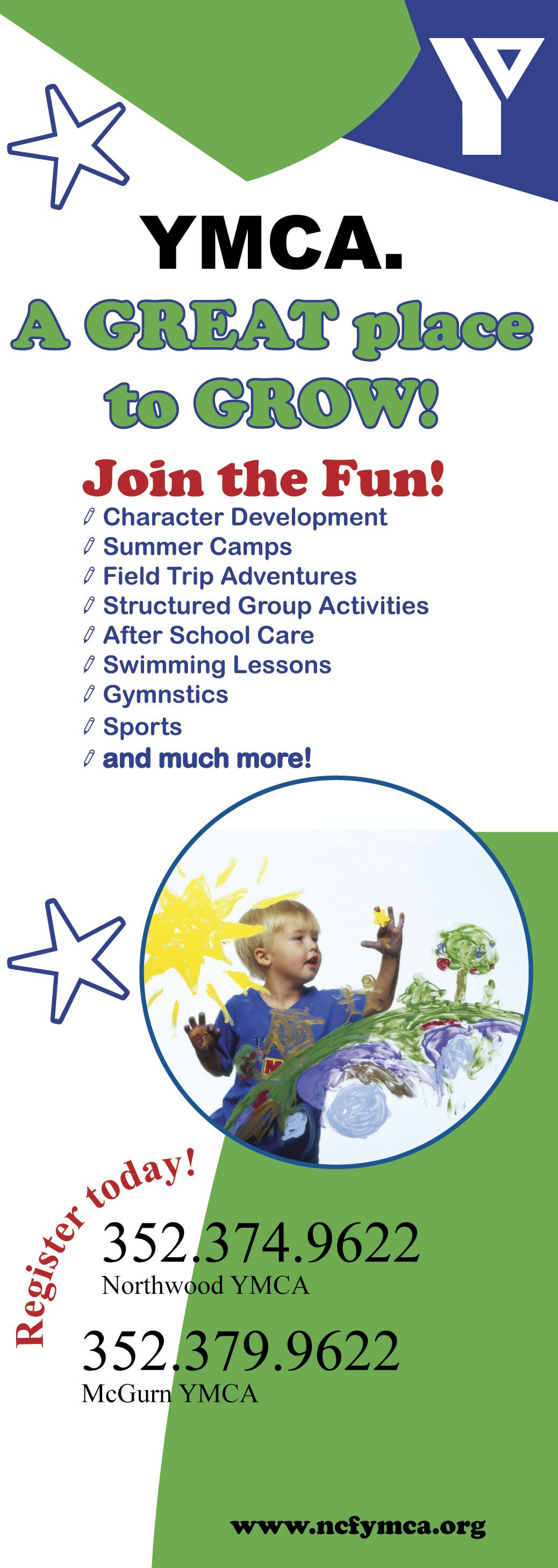
We love the Gainesville area so much, we convinced my sister to move here from Virginia. Her family has resided here with us for almost two years.
However, I must secretly admit that we have not converted to rooting for the Gators and we still quietly root for our beloved Iowa Hawkyees, where my husband went to medical school. But, give us a few more years to enjoy our life here and I’m positive that our allegiance will change. After all, our daughter was born here and I’m sure both of our kids eventually will become Gators!
Jason, Tracy, Caden, and AddisynNothing was safe from our team colors as the Gators shined at the Orange & Blue game April 18 at the Swamp.
Historic downtown Main St. in Alachua recently was buzzing with the Alachua Business League’s seventh annual Spring Festival.

The day featured a variety of craft and food vendors, plus free crafts for kids and music all day.


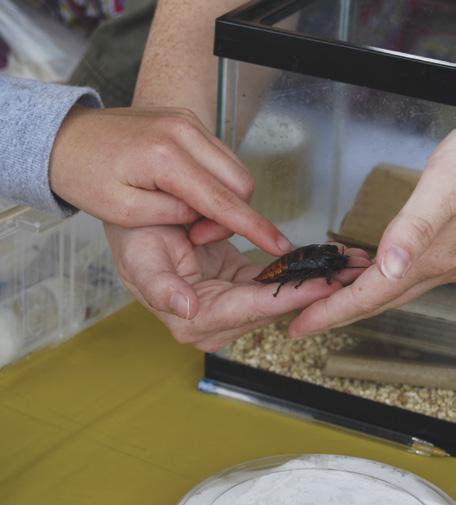

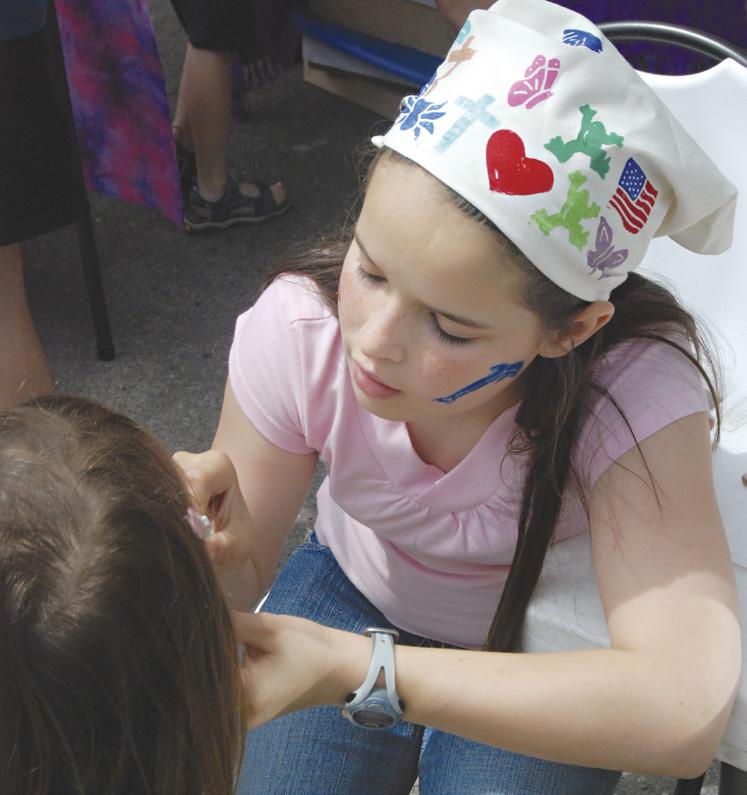
The event also featured a variety of information about community programs, including health insurance options, parenting education and library services. Plus, all of the unique shops and restaurants on the historic avenue were open for business.
raise money for their Boy
Troop


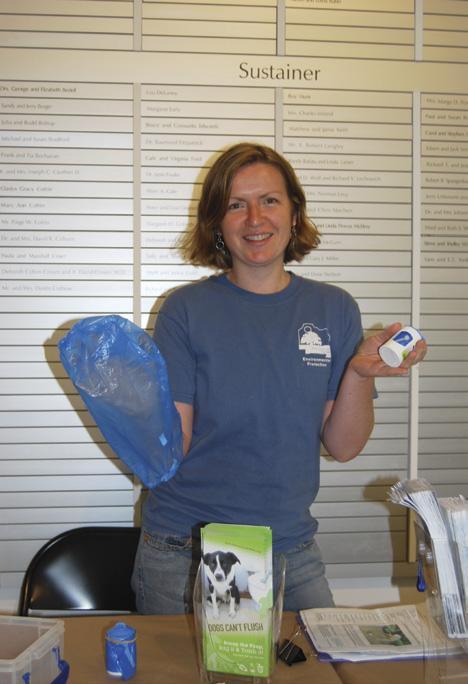
June 1
Oscar the Grouch’s Birthday
June 5
World Environment Day
Join the United Nation in its efforts to raise awareness of the environment.
Information: http://www.unep.org/ wed/2009/english/
The Great American Trailer Park
Musical Opening Night
8 p.m.
Hippodrome State Theatre
All tickets $30
Information: http://thehipp.org/
June 6
“Yulee Diddley Day”
9 a.m.
All day entertainment honoring Bo Diddley, the former Archer resident. Archer Depot downtown
www.yuleerailroaddays.org
Information: dentonph@bellsouth.net
June 6
Family Fun Day
Time: 10:00am -1:00pm
Celebration United Methodist Church
9501 SW Archer Rd
Next to SW YMCA
Information:352-367-8005
www.celebrationgnv.org
Free and open to the public
June 11
Building Your Financial Future: A Personal Financial Management Program
Learn the four concepts that will help you handle your financial resources and help you build a financially secure future.
12:30 p.m.- 4:30p.m.
Alachua County Extension Office 2800 NE 39 Avenue
Register: 352-955-2402
Information: E-mail Brenda Williams at bjcw@ufl.edu
Cost: $10
June 13
Baseball College World Series
June 14
Flag Day
June 16
National Fudge Day
June 19
GET THE LED OUT
Six musicians bring new life to the studio recordings of Led Zeppelin
7:30 p.m.
Phillips Center for the Performing Arts
Information: 352-392-ARTS (2787)
Tickets start at $15
June 20
Gainesville Gamers
All Day Gaming event (Board and Card Games)
1 p.m.-midnight
Ages 10 and up
J.Wayne Reitz Union, UF
Information: 352-392-1649
June 21
Father’s Day



